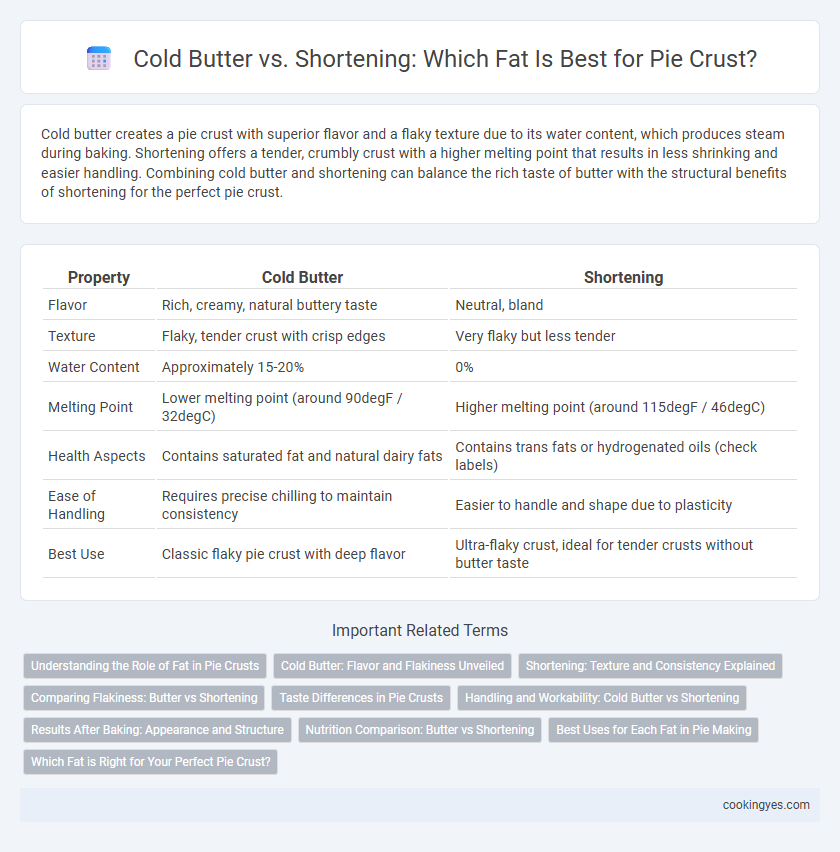Cold butter creates a pie crust with superior flavor and a flaky texture due to its water content, which produces steam during baking. Shortening offers a tender, crumbly crust with a higher melting point that results in less shrinking and easier handling. Combining cold butter and shortening can balance the rich taste of butter with the structural benefits of shortening for the perfect pie crust.
Table of Comparison
| Property | Cold Butter | Shortening |
|---|---|---|
| Flavor | Rich, creamy, natural buttery taste | Neutral, bland |
| Texture | Flaky, tender crust with crisp edges | Very flaky but less tender |
| Water Content | Approximately 15-20% | 0% |
| Melting Point | Lower melting point (around 90degF / 32degC) | Higher melting point (around 115degF / 46degC) |
| Health Aspects | Contains saturated fat and natural dairy fats | Contains trans fats or hydrogenated oils (check labels) |
| Ease of Handling | Requires precise chilling to maintain consistency | Easier to handle and shape due to plasticity |
| Best Use | Classic flaky pie crust with deep flavor | Ultra-flaky crust, ideal for tender crusts without butter taste |
Understanding the Role of Fat in Pie Crusts
Butter provides a rich flavor and creates a flaky pie crust due to its water content, which produces steam during baking, while shortening offers a tender, crumbly texture by coating flour proteins more thoroughly and preventing gluten formation. The choice between cold butter and shortening influences the crust's texture, with butter yielding a buttery, flaky result and shortening delivering a softer, more tender finish. Understanding the role of fat in pie crusts helps optimize texture and flavor, balancing moisture, melting point, and fat distribution for the desired performance.
Cold Butter: Flavor and Flakiness Unveiled
Cold butter in pie crust enhances both flavor and texture by providing rich, creamy notes and creating distinct flaky layers. Its high water content generates steam during baking, which contributes to the crust's characteristic flakiness, while the natural milk solids brown for added depth. Using cold butter results in a tender, flavorful pie crust that outperforms shortening's more neutral taste and uniform texture.
Shortening: Texture and Consistency Explained
Shortening provides a consistently flaky and tender texture in pie crusts due to its 100% fat content and higher melting point compared to cold butter. It creates a uniform dough that is easier to handle and less likely to shrink during baking, resulting in a smooth and even crust. Unlike cold butter, shortening lacks water, which minimizes gluten development and enhances crust uniformity and crispness.
Comparing Flakiness: Butter vs Shortening
Butter creates a pie crust with superior flakiness due to its higher water content, which generates steam during baking, causing layers to puff and separate. Shortening, being 100% fat, produces a tender and crumbly texture but lacks the distinct flaky layers butter provides. Combining both fats in a pie crust can balance flakiness and tenderness, optimizing the overall texture.
Taste Differences in Pie Crusts
Cold butter in pie crusts delivers a rich, creamy flavor and creates a flaky texture due to its water content, which turns to steam during baking. Shortening, being flavorless, produces a tender and crumbly crust but lacks the buttery taste that enhances the overall pie experience. Choosing cold butter enhances the depth of flavor in fruit and custard pies, while shortening is preferred for neutral-tasting crusts in savory pies.
Handling and Workability: Cold Butter vs Shortening
Cold butter creates a flaky pie crust by releasing steam as it melts during baking, but it can be challenging to handle due to its firmness and tendency to soften quickly. Shortening offers superior workability since it remains solid and pliable at room temperature, making it easier to incorporate into dough without melting. For bakers prioritizing ease of handling and consistent dough texture, shortening provides a more forgiving fat choice compared to cold butter.
Results After Baking: Appearance and Structure
Cold butter in pie crusts yields a flaky, tender texture with golden-brown edges due to its higher water content that creates steam during baking. Shortening produces a more uniform, crumbly crust with a pale appearance because it lacks water and melts uniformly, preventing browning. The choice between cold butter and shortening directly impacts the crust's visual appeal and crumb structure after baking.
Nutrition Comparison: Butter vs Shortening
Butter contains natural saturated fats and provides essential fat-soluble vitamins like A, D, and E, whereas shortening is primarily composed of hydrogenated vegetable oils, often featuring trans fats that may impact cardiovascular health negatively. Nutritionally, butter offers about 102 calories and 7 grams of fat per tablespoon, including beneficial conjugated linoleic acid, while shortening has approximately 120 calories per tablespoon with higher levels of saturated and trans fats but lacks vitamins. Choosing butter enhances flavor and nutrient content, while shortening can improve crust texture but may introduce less desirable fats nutritionally.
Best Uses for Each Fat in Pie Making
Cold butter creates a flaky, flavorful pie crust due to its water content, which steams during baking, ideal for buttery pies like apple or pumpkin. Shortening produces a tender, crumbly texture with higher melting points, making it best for savory pies and those requiring a more stable crust. Combining both fats can balance flavor and texture, enhancing pie crust performance in various recipes.
Which Fat is Right for Your Perfect Pie Crust?
Cold butter creates a flaky, flavorful pie crust due to its water content that steams during baking, while shortening offers a tender, crumbly texture with higher fat content and no water. Choosing between cold butter and shortening depends on whether you prioritize buttery taste or a more consistent, melt-in-your-mouth tenderness. For the perfect pie crust, many bakers blend both fats to balance flakiness and tenderness, optimizing texture and flavor.
Cold butter vs Shortening for pie crust fat Infographic

 cookingyes.com
cookingyes.com